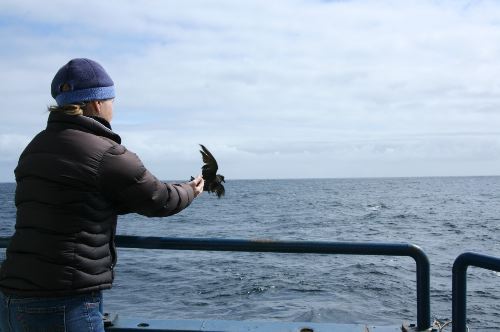Well during the night we arrived at our most northerly and westerly position of the expedition. I was up collecting water samples from the CTD (Conductivity, Temperature, and Depth) probe and it was as cold as one would expect it to be given our position. The foghorn, which is right above my cabin by the way, was going all night because of the thick fog we have been in for the last couple of days. We have since turned south and are following the 70-meter line, which will bring us back to Dutch Harbor sometime Monday. This line is called the 70-meter line because the water depth will be 70 meters for the entire length. It is known as the downhill run, but this doesn’t make the line any easier then previous sampling lines. If anything this line is more difficult because we have stations packed so closely together, and a lot of them. I’m told that the time between putting the CTD down at one station and putting it down on the next station can be between and hour and an hour and a half. That includes travel time. Obviously its longer when we have more sampling types happening (Plankton tow, multicore sample, etc.) but it still is a very hurried pace. Everyone (including myself) wants to get as much data as possible before we head for home.
Again we have had a lot of birds around. Just the other day a Leaches Storm Petrel (Oceanodroma leucorhoa) got disoriented and flew into out rear equipment hanger. It was very cold and it was clear the animal needed a rest. One of the graduate students (Heather) quickly scooped it up in order to place it into a box so it can warm up.The second she was able to do that the Storm Petrel decided to regurgitate that days meal of fish all over Heathers hands and the deck. Not very pleasant smells trust me.
 Leach's StormPetrel02
Leach's StormPetrel02
Leachs Storm Petrel and its stomach contents
Well the bird rested about an hour and Sophie one of out bird experts released it. An interesting fact about this bird is that it has an average lifespan of 20 years which is quite old fro a bird this size.
 Leach's StormPetrel03
Leach's StormPetrel03
Releasing our vistitor
The sediment group found an interesting item. Have a look in the picture. Can anyone identify it?
 Snail Egg Case 2
Snail Egg Case 2
Marine snail egg case
The scientists are saying it is a marine snail egg case. The large moon snails on the California coast have a large but different looking egg case. So if anyone can tell us more about this particular one please write in to the forum.

